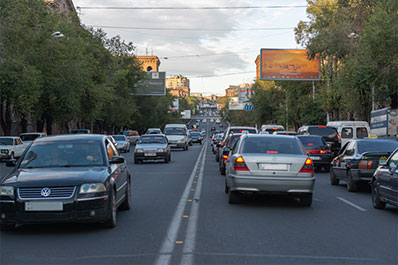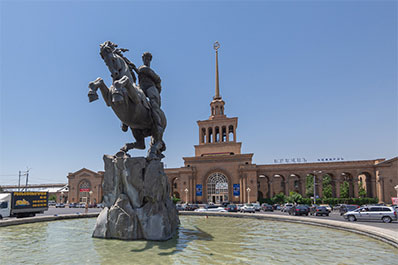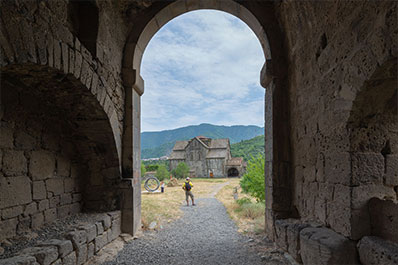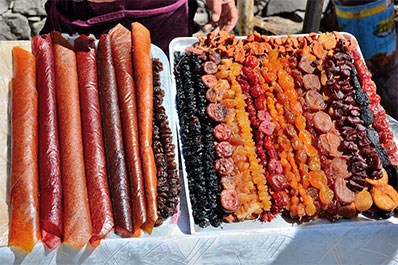Armenia Travel Guide
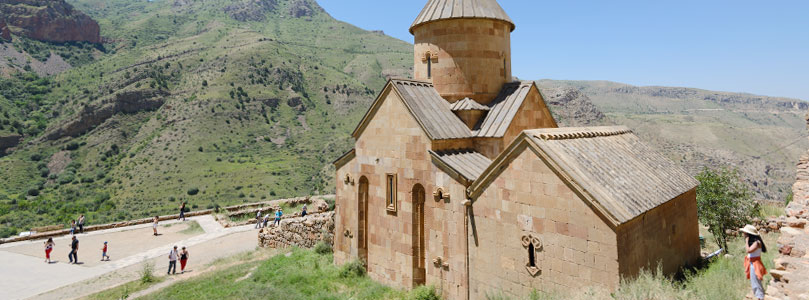
Armenia is one of the Caucasus’ understated delights, the ideal destination for any world traveler who appreciates natural beauty, ancient history, mouth-watering cuisine and the joy of visiting a welcoming country that’s not yet overwhelmed with tourists.
Only in Armenia can you wander the world’s only pink-tufted capital city, ride the world’s largest cable car and see the monastic ruins of the world’s first officially Christian nation. Bask in the picturesque view of Mount Ararat and travel the route of the ancient Silk Road, stopping at old caravanserais along the way. Enjoy a homestay with a village family, sharing laughter and stories over homemade wine.
Armenia does not attract many tourists, particularly in comparison to neighboring Turkey, Georgia or even Azerbaijan, yet it deserves far more recognition than it currently receives. Tourists to Armenia overwhelmingly find it a safe, welcoming and endearing country.
General information about Armenia
Armenia Capital: Yerevan
Population: 3.1 million (2019)
National Language: Armenian
Religion: Christian, Armenian Apostolic (94.8%), Christian, other (4%), Yazidi (1.2%)
Electricity: 230V AC, 50 Hz; type C and F round two-pin plugs are standard
Time zone: GMT+4
International dialing code: 374
Monetary unit: Armenian dram
What do I need to know before going to Armenia?
Armenia is praised by nearly everyone who visits as a safe, laid-back and strikingly beautiful country. Major tourist attractions include the capital city, Yerevan, Lake Sevan, one of the highest altitude lakes in the world, Dilijan city, dubbed ‘The Switzerland of Armenia’, Tsakhkadzor ski resort, Garni Temple and Geghard, Noravank and Haghartsin monasteries, plus hiking trails, caravanserais and pilgrimage sites.
Travelers to the region should be aware that the weather can vary greatly between Yerevan and the mountainous areas, and summer tourists in particular should pack clothing suitable for both extreme heat (Yerevan) and frigid nights (mountains).
Since the country is not accustomed to hordes of tourists, the transportation system between Yerevan and the rest of the country is not quick or reliable, and unless you’re coming with a tour group, you’ll want to have a plan in place for countryside travel.
Finally, Armenia’s land borders with Azerbaijan and Turkey have been closed for many years, so visitors planning to visit more than one Caucasus destination will want to plan their trip accordingly.
Read on for more detailed information on each of these topics and other travel tips in the Armenia Travel Guide.
What’s the best time to visit Armenia?
The best month to visit Armenia, if you want to avoid the rain, heat, snow and cold, is the narrow window from mid-May to early June or late September to early October. One of the wonderful reasons to visit Armenia, a country that sees relatively few travelers, is that even in peak season you won’t have to elbow your way through crowds of other tourists or struggle to find available accommodation.
Rainfall can be heavy in springtime, but so are the abundance of wildflowers dotting the landscape, and with generally mild temperatures this time of year, enduring the rain showers will be well worth it for some people.
Autumn likewise sees mild temps but heavier rainfall after early October, yet this is an ideal time to enjoy fresh fruits and gorgeous fall colors before the winter chill sets in.
Winters are relatively short in Armenia, but when the cold arrives it can be intense, with heavy snowfall and average temperatures of -4C (25F) around the capital and -45C (-49F) in the northwestern regions. Visitors in winter can appreciate the gorgeous mountain scenery and affordable winter sport activities including skiing, ice-skating, snowboarding, ziplining and sledding.
Summer months are hot and sunny, particularly July, which can see temps up to 40C (104F). Little rainfall is expected this time of year, but the northern mountain areas can provide respite with cooler temperatures. Roads will be clear and easier to navigate in summer, and delicious produce is sold in abundance from bazaars and roadside stands.
For travelers wanting a special experience, consider visiting over the New Year/Christmas week, from December 31st (New Year) until January 6th (Christmas). Particularly in Yerevan, these holidays are celebrated with festivals, a Christmas market, decorated trees, lights and plenteous food.
Another notable holiday in Armenia is Vardavar, which is celebrated in summer, 14 weeks after Easter. On this day people throw water on each other, so if you’re in country to celebrate, prepare to get very wet! Though the holiday has religious roots, today it’s simply considered a great way to cool off in the summer heat.
Is Armenia in the EU?
Armenia is not a part of the European Union (EU) nor does it belong to the Schengen area. While the country has no current plans to become a part of the EU, it is in direct talks with this body to promote development and cooperation.
Do you need a visa to travel to Armenia?
There are three variations of tourist visa requirements for Armenia, depending on your passport country. Note that this information pertains only to guest visas, the type of visa issued to all tourists to Armenia:
- Visa-free entry - Citizens of over 50 nations, including most CIS and EU countries may enter the country visa-free and stay for up to 180 days without an Armenia visa
- E-visa/Visa upon arrival – Citizens of many nations can either obtain a visa upon arrival at the international airport or select land border entries, or apply for an e-visa in advance. The cost and duration of the visa varies depending on the length of stay and type of visa and may be granted for a period of up to 120 days.
- All individuals not eligible for one of the options listed above must apply in person at an Armenian consulate or embassy with a Letter of Invitation (LOI). Unfortunately, such LOIs are extremely difficult to obtain, making travel to Armenia a challenge for such citizens.
For further information on Armenia tourist visas and to determine which rules apply to your passport country, please refer to our Armenia Visa Requirements page.
What airlines fly into Armenia?
The following airlines offer regular flights in and out of Yerevan’s Zvartnots International Airport:
Aeroflot
Air France
Armenia AirCompany
Atlasglobal
Emirates Airlines
Flydubai
Hahn Air Systems
Nordwind Airlines
S7 Airlines
Ukraine International Airlines
Ural Airline
UTair Aviation
Regular flights to Yerevan, Armenia fly out of Athens, Berlin, Dubai, Istanbul, Moscow, Nur-Sultan, Paris, Vienna, Yekaterinburg, Kiev, Krasnodar and St. Petersburg, as well as select smaller cities.
Flights are significantly cheaper in winter and pricier during the summer months.
Further information regarding specific routes, flights times and ticket purchases may be found on the airline websites or by contacting our travel agents.
Can you travel to Armenia by land?
Armenia shares a border with Azerbaijan, Georgia, Iran and Turkey. Borders with Turkey and Azerbaijan are permanently closed due to strained relations with these countries, but land crossings via Georgia or Iran are possible.
There is one crossing from Iran, the Agarak/Norduz border, and several between Armenia and Georgia. All of these are fairly well-maintained, open 24/7 (with the exception of the Privolnoe crossing from Georgia) and present little problems for most travelers.
Is it safe to travel in Armenia?
Armenia is considered a very safe country in which to travel, and travelers there almost unanimously state that they felt comfortable, welcome and safe their entire time in country. The capital city, Yerevan, is safe to visit, as are the suburb areas and countryside.
Occasional armed conflict and skirmishes may arise along Armenia’s border zone with Azerbaijan, and in the Armenian occupied Nagorno-Karabakh, which remains a disputed territory between the two nations. Travel to the border zone is discouraged (and not essential, as the Armenia-Azerbaijan border is closed anyway). For more information on Nagorno-Karabakh, see ‘Is Nagorno-Karabakh safe to visit?’ below.
Although Armenia has a low rate of both violent and petty crime, the usual precautions should be observed when traveling – keep your passport in a secure place and watch your valuables when in crowded areas and on public transport. Be aware of your surroundings when withdrawing money from ATMs or carrying large amounts of cash or valuables.
The biggest nuisance that many tourists will face in the country is the condition of the roads, which can be poorly maintained, particularly outside of the cities and in wintertime. Due to these conditions, traveling between cities after dark is discouraged unless you’re with an experienced driver.
Is Armenia safe to travel alone?
As stated above, Armenia is generally a very safe country with an extremely low rate of crime, and most solo travelers report feeling safe their entire time in country. Should you find yourself in need of any kind of help, most people will go out of their way to assist you in any way that they can. Women traveling alone rarely report difficulties, feeling safe and free to travel at will, including in the more isolated parts of the country.
If you don’t speak Armenian or Russian, the language barrier can be a challenge for solo travelers, as few people speak English outside the capital. Budget hotels outside the capital may be limited, although homestays will usually be available. Solo travelers also face the added expense of hiring a private car or driver to the more remote tourist sites, where reliable public transport may be limited, slow or overcrowded.
For those with the time and a spirit of adventure, the public buses, vans and trains can be a fun option. For others, consider joining a budget group tour with adequate free time built into the schedule, which can alleviate much of the hassle of private travel while still allowing for independent exploration. Or, connect with other tourists in the country to share the cost of onward transportation.
Is Nagorno-Karabakh safe to visit?
To visit the disputed territory of Nagorno Karabakh, you can technically cross anywhere from Armenia but are advised to pass through the official checkpoint at Tegh – Berdadzor. You must receive a visa for this territory in advance, regardless of whether or not you have a valid Armenian visa or entered the country visa-free. A 21-day single entry visa to this region may be obtained in Yerevan.
Although you will not receive a stamp in your passport as having left and/or re-entered Armenia, you will receive a stamp that you have entered Nagorno-Karabakh. If you’re planning further travel into Azerbaijan, you should request that this stamp be placed on a separate sheet of paper, as Azerbaijan does not permit entry to anyone who has visited Nagorno-Karabakh. Stamp or no stamp, if Azerbaijan discovers that you’ve visited Nagorno-Karabakh, you will be permanently banned from entering the country.
Can you drink the water in Armenia?
Tap water in Armenia is very safe to drink and rumored by many Armenians to be some of the purest and most refreshing in the world. You’ll also see many stone fountains, or pupulak, in cities and towns throughout the country. These are public water fountains flowing with fresh spring water and are also safe to drink.
For those who remain wary, bottled water can easily be purchased at convenience stores across the country.
What language do they speak in Armenia?
Armenian is the national language of Armenia, the mother tongue of most of the population and the language you’ll hear most in day-to-day interactions.
Armenian is an Indo-European language known for its distinct features, unique alphabet and influence from the ancient Greek and Parthian languages. It’s one of the most ancient languages still spoken in the world today, with roots that go back at least 1600 years.
The Armenian alphabet has 38 letters and is written in a unique script. There are two variations of the language, eastern Armenian and western Armenian. Eastern Armenian is spoken in Armenia and by the Armenian population in neighboring Iran. Western Armenian is the language used by the Armenian diaspora in Turkey and the West. These two variations are, for the most part, mutually intelligible with one another.
Russian is also widely spoken in Armenia and understood by nearly everyone, thanks to Armenia’s history as a state within the Union of Soviet Socialist Republics (USSR) until 1991. Other minority languages in Armenia include Kurdish, Greek and Assyrian.
Do they speak English in Armenia?
English is studied as a second language by most schoolchildren, although it’s not nearly as widely spoken as Russian. Limited English is spoken by many of the younger people in Yerevan and those in the tourist industry. In addition, street signs and other official notifications will be written in Armenian and English.
In reality, only a small minority of the population understands anything more than basic English, particularly outside the capital. For more in-depth communication with locals in English, the use of an English-Russian dictionary or translator, or a private tour guide, will be helpful.
What food do they eat in Armenia?
Armenian cuisine has its roots in ancient times and continues to delight tourists with its variety and flavor. Staples of Armenian food include meats, flatbread and sweets. Dishes are often cooked with an array of spices using little fat. Be sure to try these most popular foods while in country:
- Tolma (Dolma) – Armenians have perfected the art of stuffed grape leaves, and have dozens of varieties of this regional specialty, prepared with all types of leaves, peppers, meats, rice and vegetables. You haven’t really tasted dolma until you’ve eaten it in Armenia!
- Khorovats (Meat kebab) – a staple throughout Cacuasus and Central Asia, Armenia boasts of over twenty varieties of this popular dish, each made with a different type of meat, marinated in a special bland of sauces and cooked in a unique way.
- Basturma (smoked beef) – this seasoned dried beef is a popular appetizer throughout Armenia.
- Ghapama – Popular during the winter holidays, ghapama is a hollowed-out pumpkin stuffed with rice and dried fruits, then baked until soft and hot.
- Harrissa (Meat and wheat porridge) – a hearty, healthy food made from wheat and chicken or lamb, it’s popular in springtime.
- Khash (Cow’s hoof) – While it may sound strange, this is a popular dish served as a soup or with relish and surprises many tourists with its delicious taste.
Other popular foods include manti (steamed dumplings), kufta (meatballs) various pilafs, fish, lavash (thin tortilla-like bread), sweet and savory pastries and dried fruits and nuts.
Vegetarians will have little difficulty finding suitable meals, as Armenia offers a variety of vegetarian soups, salads, fresh dairy products, cheese, and dishes prepared with aubergine, lentils, beans and nuts. Consider trying the local specialties matsun (thick sour milkj), various apur soups (vegetable soups) and eetch, a dish consisting of bulgur, lemon, tomatoes, onions and spices.
Armenia has likewise been producing wine for thousands of years and is famous for its wide selection of brandy, vodka and wine. Visitors will enjoy tasting mulberry vodka, fruit and sherry wines, local brandy and oghi, also known as Armenian vodka.
What should I wear in Armenia?
There is no dress code enforced in Armenia, and travelers are free to dress as they like. Typical Armenian dress reflects a conservative, European style, with a general preference for dressy over casual attire. The summer months in Yerevan and its surrounding regions is often sweltering hot, yet during a trip to the mountains this same time of year you could experience evening temperatures that are close to freezing. Necessary items you’ll want to pack for your trip to Armenia:
- For summer, comfortable sandals and flip-flops; hat, sunglasses and sunscreen; cool, light clothing for Yerevan and hiking boots, layered clothing, gloves and a jacket for the mountains
- For spring and autumn, layered clothing and light sweaters, plus a rain jacket or umbrella and warm attire for the mountains
- In winter, warm clothing and boots with good traction for the southern region and full winter gear for the mountains
Smaller towns and more remote areas will be more conservative than the cities, and while tourists may wear shorts and sleeveless shirts, you will not see the local residents doing so. Women may want to bring a head covering for visits to select monasteries and other religious sites.
Is Armenia an Islamic country?
Armenia was the world’s first officially Christian nation, having declared it to be the state religion in 301 AD. The vast majority of the population officially belongs to the Armenian Apostolic Church, although today many younger people are nonreligious in practice. Religious freedom is guaranteed to all faiths, and minority pockets of Muslims and Yezidis can be found in Yerevan, as well as a functioning 18th century Shia mosque.
Can I use credit cards in Armenia?
While Armenia is largely a cash-based society, credit and debit cards are accepted at many stores and cafes in Yerevan, and ATMS accepting Visa, MasterCard, Maestro and American Express are easy to come by.
Once you leave the capital, however, working ATMs can be challenging to find and credit cards will not be accepted at most places. Thus all tourists are advised to exchange or withdrawal adequate amounts of cash with them before leaving Yerevan.
Euros, dollars, pounds and rubles can all be widely exchanged in the capital. Banks generally provide a lower exchange rate, while 24/7 exchange offices will offer a better rate. Exchange as little as possible at the airport, where the rates tend to be the worst.
Does Armenia have internet?
Internet is widespread in Armenia and generally has good speed. In Yerevan, free WiFi can be accessed in most cafes and restaurants as well as many public spots such as parks and city buses. Most if not all hotels and guesthouses provide free Wi-Fi.
Once you leave the capital, free Wi-Fi may be harder to find outside of your hotel. For regular internet access, particularly if you’ll be in country for more than a few days, we recommend purchasing a local SIM card.
Primary mobile carriers in Yerevan include Beeline (Veon Armenia), UCom and Viva Cell MTS. All three companies offer adequate services and a wide range of plans. Tourists may purchase a SIM card for a few dollars at any official store, including at the airport, a 24/7 store in the city center and at smaller stores all across the country.
Mobile service is quite good throughout Armenia, except for more remote mountainous areas. Armenian SIM cards will not work in Azerbaijan or Georgia.
Is Armenia expensive to travel?
Armenia is an affordable country to visit and while there are some unexpected costs, travelers on all different budgets will generally be able to stay within their price range. A breakdown of current prices that travelers in Armenia can expect:
- Accommodation – the full range of hostels, hotels, private rentals and homestays can be found for as little as $10, with ritzier accommodation upwards of $300 in Yerevan. A basic but private room in Yerevan averages $15-$20 per night, with mid-range hotels starting at $50. If you plan to stay overnight in small towns or villages, simple hotels or homestays may be your best option. Expect to pay $10-$20 per person for homestays, which often include meals.
- Food – a wide range of food options are available in Armenia, from purchasing your own products at the bazaar to street cafes, mid-range restaurants to international cuisine. The average person could expect to spend $10 -$20 on food per day.
- Transportation – Transportation in Armenia can be quite tricky. The cheapest option by far is to use public transport, yet outside of the capital transport by bus, van or train may be unreliable, particularly to tourist sites that are less frequented by locals. Options include renting a car, hiring a driver or traveling in a tour group, where transportation will be fully provided. In Yerevan, it’s possible to travel on foot, public bus or low-cost taxis.
- Entrance fees to sites – Most sights are either free to enter or have a low entrance fee of $5 or less, although many sites contain little background information written in English.
- Skiing and winter sports – Expect to pay $50-$75 per day for skiing and snowboarding, plus food and lodging
- Camping and mountain treks – Armenia’s hiking trails have greatly improved in the past year, and most can be accessed for free or at a minimal cost. If hiking on a lesser-marked trail or planning for a multi-day trip, consider joining a tour or hiring a private guide. Camping gear and tents can be rented for approximately $15-20 per person per day.
- Flights in and out of Armenia – International flights to Armenia can be pricey, as it is not a well-serviced location. Consider curtailing these costs by flying in the off season or by combining a trip to Armenia with a tour of Georgia, from which you can enter Armenia by land from several border crossings.
What kind of souvenirs can I buy in Armenia?
Armenia offers tourists a great selection of local gifts and souvenirs to choose from, so be sure to leave some space in your luggage for everything you’ll end up purchasing!
Local wine and brandy, sold in bottles of all sizes, can be purchased and packaged up for you to take home to grateful friends and family members, a great way to give them a taste of Armenia.
Pottery reflects the Armenian tradition of craftsmanship, and locally made ceramic dishes and figurines of varying colors and designs can be purchased.
Armenians have a history of silversmithing and silver rings, bracelets, necklaces and earrings imprinted with national emblems can be found for all styles and costs.
Pomegranates are considered a national symbol in Armenia, and you’ll see them depicted everywhere. Gifts that reflect this aspect of Armenian culture, such as ceramic pomegranates or wall hangings with this fruit artfully woven into the fabric, can be found at many bazaars and gifts shops.
Carpets are worth the cost and weight for art connoisseurs. Armenian carpets are known for their ornamentation, depiction of religious and cultural images, special designs and firmly woven nature.
Hand-carved wooden trinkets, religious symbols, wall hangings and board games are popular with many tourists.
Edible gifts, including dried fruits, nuts, sausage, cheeses, baklava and packets of spices are delicious and easy to carry back home.
If you’ve found this Armenia Travel Guide helpful, check out our travel guides for other Central Asian and Caucasus nations to learn more about the region!

